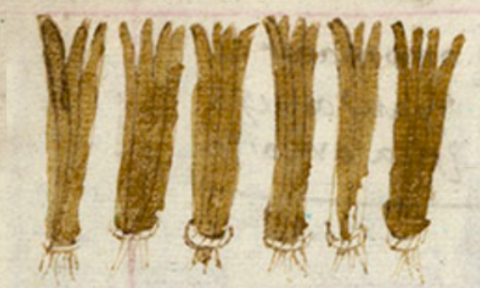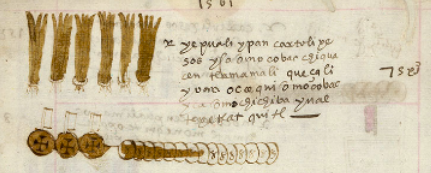quetzalli (CST44)
This painting of the simplex glyph for the term quetzalli (quetzal feathers) shows a horizontal row of six tied bundles of these feathers. They may have been green once, but now they are a brownish color.
Stephanie Wood
For more on the Codex Sierra, see Kevin Terraciano’s study (2021). Terraciano refers to alphabetic and “pictorial” writing, which we are counting as hieroglyphic writing. We are also including examples of “iconography” where the images verge on European-style illustrations or scenes showing activities that highlight people or objects that might help with hieroglyphic analysis. Hieroglyphic writing was evolving as a result of the influence of European illustrations, and even alphabetic writing impacted it.
Stephanie Wood
1550–1564
Jeff Haskett-Wood
plumas, pájaros, quetzales, atados

quetzal(li), quetzal bird feathers, https://nahuatl.wired-humanities.org/content/quetzalli
quetzales
Stephanie Wood
Códice Sierra-Texupan, plate 44, page dated 1561. Origin: Santa Catalina Texupan, Mixteca Alta, State of Oaxaca.
The Biblioteca Digital Lafragua of the Biblioteca Histórica José María Lafragua in Puebla, Mexico, publishes this Códice Sierra-Texupan, 1550–1564 (62pp., 30.7 x 21.8 cm.), referring to it as being in the “Public Domain.” https://bidilaf.buap.mx/objeto.xql?id=48281&busqueda=Texupan&action=search. This image is published here under a Creative Commons license, asking that you cite the Biblioteca Digital Lafragua and this Visual Lexicon of Aztec Hieroglyphs.



